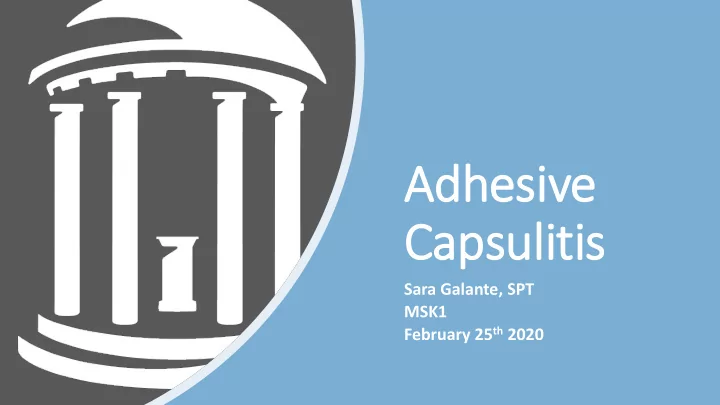

Adhesive Capsuli litis Sara Galante, SPT MSK1 February 25 th 2020
1. Distinguish between primary and secondary adhesive capsulitis. 2. Analyze data from the subjective and objective parts of the case study to narrow a differential diagnosis list. 3. Identify the stage of adhesive capsulitis in Objectives a patient presentation. 4. Describe the pathology and natural course of disease to a patient in health literacy friendly language. 5. Apply clinical practice guideline information to create a salient treatment plan.
Patient FW aka “Fred” Referral for Impingement Syndrome • 66 year old male • Insidious onset of R shoulder pain 6 mon prior • Intermittently radiates to elbow Anything else Are they • Received cortisone shot from MD resulting in appropriate you want to temporary relief for PT? know? • Aggs : sleeping on his R side, showering, reaching • Hx : DM, L rotator cuff injury 40 years prior • Retired, homemaker due to wife’s radiation treatments, enjoys playing cards
“Fred” Differential Dx Dx Cervical Spine Pathology Adhesive Capsulitis Impingement How do you RC tear narrow them Neoplasm down? Nerve Entrapment Humeral Head Fx Contusion of Shoulder Chronic Regional Pain Syndrome Fibromyalgia Arthrosis
Adhesive Capsulitis AKA “Frozen Shoulder” 1,3,4 • Fibrosis of GH capsule with chronic inflammatory response • Affects between 2 - 5.3% of population • Primarily 40-65 yo, female • Risk Factors • Previous episode of Ad Cap in contralateral arm • T2DM (30%) • Thyroid Disease (13.4%)
Pathoanatomy 1,4 • Tightness in subscapularis • Cadaver study suggests that greater loss of ER at 45° ABD vs 90° ABD could indicates subscapularis restriction • Multiregional synovitis consistent with inflammation + angiogenesis with new nerve growth • Capsular Fibrosis and contracture • Decreased volume of fluid in joint capsule seen in arthrogram (16-20 ml decreased to 5-10ml)
Primary Secondary • Idiopathic • Systemic • Not associated with • Hx of DM, Thyroid Disease systemic condition or • Intrinsic history of injury • GH Joint pathology • Theorized to be • Disuse or immobilization Primary vs. chronic inflammatory from pain causing pathology response with Secondary 1 • Extrinsic fibroblastic • Pathology not related to proliferation shoulder • Results in painful, stiff shoulder
“Fred” - Objective C-Spine Clear ROM: • L Shoulder: WNL (T4 for IR behind back) • R Shoulder: 135 (flex), 155 (ABD), 50 (ER at 0), L3 (IR behind back) MMT: • 4/5 B (except R IR 2/5) 28/55 on Quick DASH Shoulder Questionnaire • Indicating 45% disability PROM in supine limited in all directions (IR>ER>ABD) Hypomobile sup → inf and AP mobilizations Subscapularis TTP
Patient Presentation 1-2 • Gradual progressive onset of pain • Often described as dull ache • Pain lying on affected side • Pain at end range of movement • Difficulty reaching • Shrug Sign • Capsular Pattern ER > ABD > IR • Varied results with strength and pain during MMT • Special tests unhelpful for ruling in
4 Stages 1 Stage 1: Stage 2: Stage 3: Stage 4: • <3 months • Month 3-9 • Month 9-15 • “Thawing” Stage • Sharp pain at end • "Painful" or • ”Frozen” stage • Pain begins to • Pain and loss of range "Freezing" stage resolve • Achy pain at rest • Gradual loss of • Significant stiffness motion • Sleep Disturbances • Progressive motion in all persist for months • Misdiagnosed as directions due to capsuloligamentous 15-24 impingement due pain fibrosis • Significant Synovitis to good motion • Limited motion available under anesthesia
Treatment 1,2,6 Non-Operative Operative • Intraarticular • Manipulation under corticosteroid injection** anesthesia • 4-6 wks pain relief • Arthroscopic capsular • Oral Corticosteroids release • NSAIDs • Open surgical release • Physical Therapy • Brisement **= Supported with strong evidence in JOSPT CPG *= Supported with moderate evidence in JOSPT CPG
Physical Therapy Treatment 1 • Patient Education* • Describe natural course of disease • Promotes activity modification to encourage functional • Match intensity of stretching to pt’s current level of irritability • Modalities • Joint Mobilization • Stretching* • Intensity determined by pt irritability • Remain in pain free range **= Supported with strong • Strengthening* evidence in JOSPT CPG *= Supported with moderate • Posture re-education, pain-free range evidence in JOSPT CPG
Treatment for “Painful” 3 • Postural positioning • Manual techniques • to relieve muscle involvement • Modalities • relief of inflammation (secondarily pain) • Grade I/II mobs • long axis distraction • Maintain existing ROM
Treatment for “Thawing” 3 • AAROM • Gr III/IV Mobs • Ultrasound • Anterior / inferior capsule • Aggressive ROM • Home exercise program throughout day for ROM • Strengthening RC / Periscapular
Patient FW aka “Fred” Pt Education w/ teach back Update: FW Pain Motion Strength/Control d/ c’ed to Pendulums Towel Slides- ABD Scapular retractions independent Heat Sleeper Stretch- IR OH Ball on Wall HEP after Isometrics Pulley Education for return meeting or Gr 1-2 Mobs + Dowel Rod AAROM to gym program Distraction Towel Stretch almost meeting behind back all of his goals
References 1. Kelley MJ, Shaffer MA, Kuhn JE, et al. Shoulder pain and mobility deficits: adhesive capsulitis. J. Orthop. Sports Phys. Ther. 2013;43(5):A1-31. doi:10.2519/jospt.2013.0302. 2. Kisner C, Colby LA. The Shoulder and the Shoulder Girdle. In: Therapeutic Exercise: Foudations and Techniques . 6th ed. FA Davis Company; 2012:539-617. 3. Zreik NH, Malik RA, Charalambous CP. Adhesive capsulitis of the shoulder and diabetes: a meta-analysis of prevalence. Muscles Ligaments Tendons J. 2016;6(1):26-34. doi:10.11138/mltj/2016.6.1.026. 4. Huang S-W, Lin J-W, Wang W-T, Wu C-W, Liou T-H, Lin H-W. Hyperthyroidism is a risk factor for developing adhesive capsulitis of the shoulder: a nationwide longitudinal population-based study. Sci. Rep. 2014;4:4183. doi:10.1038/srep04183. 5. Turkel SJ, Panio MW, Marshall JL, Girgis FG. Stabilizing mechanisms preventing anterior dislocation of the glenohumeral joint. J. Bone Joint Surg. Am. 1981;63(8):1208-1217. 6. Page MJ, Green S, Kramer S, et al. Manual therapy and exercise for adhesive capsulitis (frozen shoulder). Cochrane Database Syst. Rev. 2014;(8):CD011275. doi:10.1002/14651858.CD011275.
Questions?
Recommend
More recommend